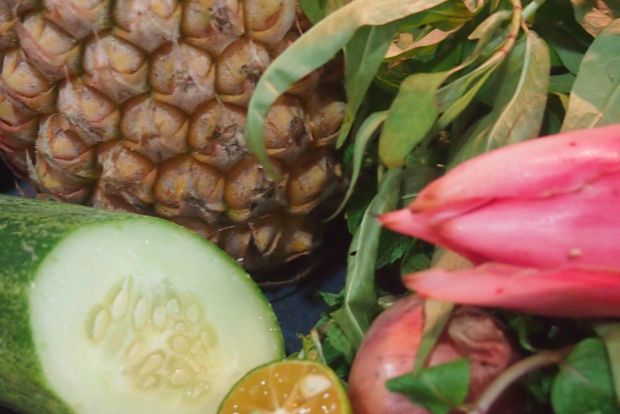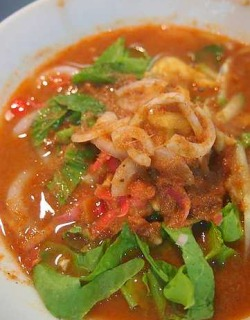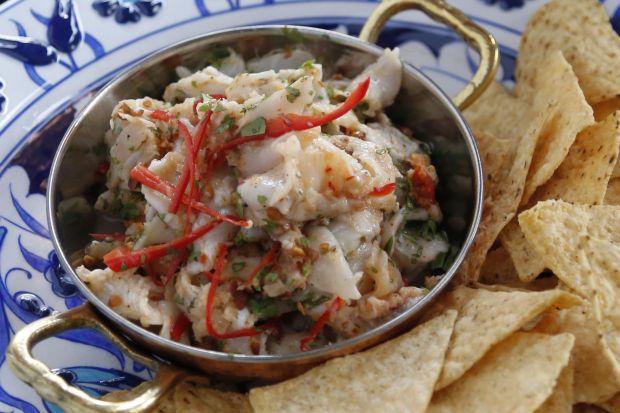The sensational Assam Laksa is worthy of its place as one of the most delicious foods in the world.
FOOD is wonderful, isn’t it? It nourishes our bodies, and also provides intellectual stimulation – case in point being the recent debate about Penang’s famous Assam Laksa making CNNGo’s list of the world’s 50 most delicious foods.
Although it’s not everyone’s cup of tea (or bowl of noodles, as the case may be), it didn’t just slip in at the tail end, but put a fair few noses out of joint by coming in at a very respectable No.7. This is quite an accolade, and a well-deserved one at that, although rather disappointingly, it was the only one of our diverse range of foods to make it.
That our very own favourite has been given international recognition comes as no surprise; rich in a smorgasbord of flavours, a good Assam Laksa should encompass the four sensations which most appeal to our taste buds: the gravy is piquant and sour, yet salty and sweet at the same time.
Fresh lemon grass and chiam hom (daun kesom) add a contrasting lift as the flaked fish, belacan (fermented prawn paste) and optional hey ko (black prawn paste) can be rather overpowering.
It’s ladled over thick white rice noodles topped with plenty of julienned pineapple, onions, cucumber and mint together with a sprinkling of refreshing bunga kantan (pink ginger bud flower).
Mmm … writing this article made my mouth water, and I was inspired to close laptop and cook it for the family. Which made the report from China Press about Penangites being “too lazy” to cook it, preferring instead to eat it at hawker stalls, even more interesting.
It stands to reason: the dish is ubiquitous, available at practically every corner of the state, so why indeed should one bother?
But it’s actually not that difficult to make. Check out the lazy man’s recipe I’ve included – and tested in my own kitchen – for those who want to give it a go.
Ok ok, so if you do find it’s too much trouble, where exactly does one head to eat it? We have many, some well-known, others less so, and certainly far too many to mention.
Actually, “Penang Assam Laksa” is a broad generalisation, as there are so many versions available, each with its own characteristics. As the saying here goes, “korlang korlang” – it’s all subjective, and everyone has their favourite stall and individual taste.
Mizi has been selling his Tanjung Bungah Laksa by the road at Shamrock Beach for nearly 15 years. His is a light gravy served over reconstituted chor (coarse) bee hoon, popular with day trippers who visit the seaside to makan angin (holiday).
A bit further away in Hillside, Ah Hooi’s version is much more intense, the soup a dark brown from the liberal use of thick tamarind juice; a popular way of eating this is to cham (mix) with his Curry Mee gravy, resulting in a soup which is both sour and lemak (creamy).
If I’m ever in the area around teatime, I make it a point to stop at the entrance to Prima Tanjung, where Rajah serves his Nyonya Laksa the traditional way: from the back of his vehicle, which comes complete with charcoal burner to keep the gravy boiling hot.
People eat standing up, congregated around his motorbike, occasionally reaching out for a crispy golden spring roll to dip into the remaining soup; this softens the skin slightly yet maintains the crunch, creating an aromatic melange of flavours and textures.
The rest of the soup is then polished off, literally drunk from the bowl, every last drop savoured, followed perhaps by a piece or two of Kueh Talam.
Another popular stall is at the Taman Emas Kopitiam opposite the Peng Hwa Chinese School on Gottlieb Road, which serves a lighter, sweeter version with plenty of fish.
When I was in Prangin Mall one afternoon, I discovered this place literally by following my nose: on descending to the ground floor, my olfactory nerves were assailed by the distinctive wafts of what could only be belacan cooked in tamarind.
Sure enough, I tracked it down to a little corner outlet with a very limited menu: just Assam Laksa and Rojak. However, it also serves Cendol, as it is a branch of the famous stall in Lebuh Keng Kwee, Penang Road, next to the Joo Hooi Café, which happens to have a well-known Assam Laksa stall too.
If you’re heading out of town, there’s a laksa stall at the junction of Weld Quay and Gat Lebuh Aceh, and over on the other side of the island, I’ve mentioned Eh Kao’s Air Itam Laksa; in Balik Pulau Kim is still dishing out bowlfuls every afternoon at the Nan Guang Kopitiam, together with the more lemak Siam Laksa.
These are but a handful of the many hawkers whose hard work has enabled us to enjoy Assam Laksa over the years, and given Penang this latest in a string of awards. Well done, guys, and thanks!
Helen Ong’s Lazy Assam Laksa
REMEMBER: agak-agak (guesstimate) is the key here; adjust amounts accordingly and although the asterisk implies optional items which means they can be left out if you don’t have them, substitute if possible or where necessary.
I always have a tin of sardines, pilchards or even salmon in my larder, lemon grass in my freezer and if there’s no assam, I’ve been known to use lime juice – after all, needs must. It may take three hours in total to cook, but most of that time is taken up with simmering, and preparing the garnish.
Given a bit of practice, the gravy can be rustled up at quite short notice (although it tastes even better if left overnight) especially if double amounts of the rempah (chilli paste) are prepared and one lot frozen in readiness for the next time – for sure you will want to try this simple recipe again!
Rempah (Spices)
2-3 large onions, peeled then cut into 8 pieces each (or 15 shallots)
10 dried chillies, soaked in hot water then drained
10 fresh chillies, cut into ½” pieces
(the dried and fresh chillies can together be substituted with 2-3 tbsps of good chilli powder)
1 bunga kantan, cut into ½” pieces*
2 stalks lemon grass, sliced into thin rounds
1/2 piece of fresh turmeric or ½ tsp of turmeric powder*
1-2” square piece fresh belacan, more if you prefer it “fishy”
1in fresh lengkuas*
Gravy
3 litres water
Canned fish, 1 large tin, finely minced, or 3-6 fresh fish, cleaned (Kembong [mackerel] or Yellow Tail is usual, but I’ll use anything that is available at the market)
2-3” square tamarind, soaked in 1 cup of hot water then the juice squeezed out
A few sprigs of chiam hom (Vietnamese coriander)
5-7 pieces assam keping*
Salt and sugar
Garnishing (optional)
Fresh lettuce, washed and julienned
Fresh mint, washed and de-stalked
Fresh pineapple, skinned and julienned
Fresh cucumber, skinned and julienned
Large onion, skinned and sliced thinly
Bunga kantan, finely chopped
Fresh red or green chillies, thinly sliced
Black hey ko, mixed with boiling water to a more malleable consistency
Kalamansi limes (kiat lah or limau kasturi), halved
Fresh laksa noodles or dried laksa noodles/spaghetti/bee hoon (follow instructions to cook)
Method
Blend all rempah ingredients together with a bit of water till smooth. This is much easier than bruising the lemon grass and adding it separately. It also adds more flavour to the gravy, and saves having to remove it later.
Bring water to the boil in a large pot, add tamarind juice, slices and rempah, bring to boil again.
Add fish. If using fresh, boil for 10-15 minutes till cooked, take out and when cool enough to handle, flake the skin making sure all bones are removed. Put fish back into the stock.
Add chiam hom, bring to the boil again and simmer for at least half an hour – the longer you leave it, the better it will taste; if necessary top up with boiling water. Season to taste with salt and sugar.
Serve with noodles and garnish.
Enjoy!






